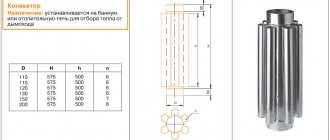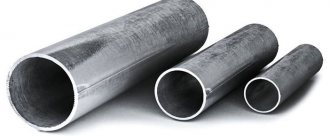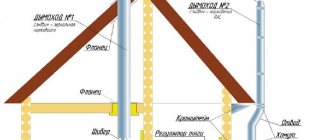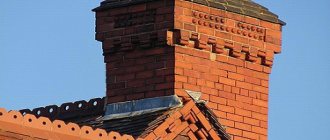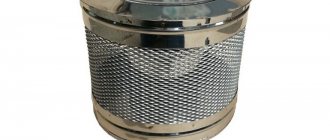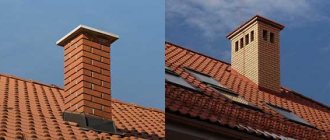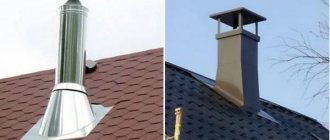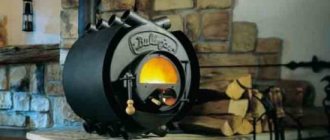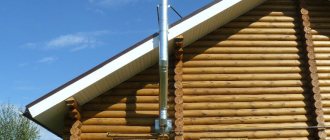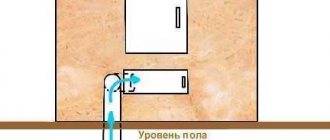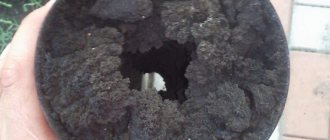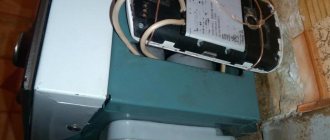Traditional methods for cleaning soot from chimneys
We never liked cleaning the chimney mechanically - there was a lot of dirt.
In ancient times there were no chemicals, but our people are very savvy and a solution was found. It was experimentally determined that it is possible to clean a chimney by burning aspen wood or potato peelings in the firebox. Aspen firewood produces great heat, which burns away soot. Using this method you need to be extremely careful. If you have, for example, then it’s better not to risk it. Potato peelings remove soot due to the combustion of starch, or rather the smoke that is released. To prepare the peelings, you need to spread them in a warm place so that all the moisture is gone. If you throw them into a bucket wet, they will simply become moldy and rot.
Blowing the chimney with air yourself
There is another option for cleaning a chimney in a stove from soot using folk remedies - this is through strong air pressure. The bottom line is that a turbulent flow is created in the chimney, which blows all the dirt out. The main thing is a powerful fan. As an air blower, you can use a chainsaw or a special device for cleaning the area (they blow off leaves in the fall). The fan must draw the flow out of the pipe - otherwise all the soot will go into the house and then there will be no time for experiments. In the video below you can see how to clean a chimney with air in a few minutes.
Russian baths are associated with wet steam and a wood stove. And where the stove is heated, there is always a chimney. Caring for it includes periodic cleaning. If you don’t do this, then the heating of the bathhouse will get worse and worse every year. The thrust will simply decrease, and this will reduce efficiency. Sooner or later, everyone wonders how to clean a pipe in a bathhouse. We will tell you how to clean effectively, without extra costs.
How to clean a pipe in a bathhouse with a special brush.
Use of chemical reagents
Chemicals for cleaning the chimney in a bathhouse serve more to prevent excessive accumulation of soot than to actually remove it. Such substances are not able to completely remove plaque without the use of mechanical cleaning methods.
Chemicals for cleaning the chimney in a bathhouse serve more to prevent excessive accumulation of soot than to actually remove it. Such substances are not able to completely remove plaque without the use of mechanical cleaning methods.
In addition, most of them have a strong, unpleasant odor that will dissipate within a few days. However, it is worth noting that, as a last resort, you can use tools such as “Log Chimney Sweep” or “Komichek”.
How to reduce chimney pollution?
It is common for different types of heating devices to accumulate soot in the smoke ducts at different rates. So, the more protrusions, roughnesses and irregularities, the more soot settles on the walls. Numerous turns or improperly laid smoke channels also prevent soot from escaping into the atmosphere.
But if the stove, fireplace, boiler are already installed, then there is no way to change its design. But you can minimize other negative factors that lead to severe contamination of the chimney.
Choosing the optimal fuel
When any fuel burns in a chimney, a deposit of soot and soot forms. But one type can form more deposits than others. The intensity of pollution can be reduced if you use the “right” fuel.
Wood from different tree species has different chemical composition. Different contents of resin, oils, tar, and creosote affect the degree of sediment formation on chimney pipes. The less these substances are in the wood, the less soot will be formed during the combustion process. Other types of solid fuels also contribute to pollution to varying degrees.
Which fuel produces soot more strongly than others:
- firewood from coniferous species - spruce, pine;
- birch firewood, which has a high tar content;
- Briquettes and pellets made from seed husks, due to their high oil content, produce intensive soot formation.
It should also be said that burning household waste, especially plastic, in a stove also contributes to the formation of plaque.
In contrast to these types of fuel, firewood from oak, hornbeam, beech, walnut, sycamore, pear, and apple can be noted. These hard rocks are much less likely to cause contamination of smoke ducts.
Briquettes made from sawdust, otherwise called Euro-firewood, burn well and leave a little soot behind. When burning, they do not spark, and weakly absorb moisture, so they can be stored in kitchens next to the stove.
Dependence on humidity and combustion temperature
It is highly advisable to use dry wood for heating premises - the drier the better. The fact is that when wet fuel is burned, the ash, under the influence of steam, rises with it and sticks together into lumps. It becomes heavier and cannot leave the chimney. As a result, it accumulates inside the chimney in the form of soot.
Therefore, they need to be prepared in advance and stored under a canopy, in special covered premises, sheds. In such conditions, it will be possible to achieve 15-20% humidity. In this case, the degree of dryness will always fluctuate depending on the air humidity indoors and outdoors.
The amount of soot formation is also affected by the combustion temperature. The worse the firewood burns, the greater the degree of contamination, the more often the chimney will have to be cleaned.
This is due to the fact that at low temperatures an excess of carbon particles is formed, which settles in the form of soot and soot. This phenomenon is especially typical for the initial combustion, when the wood is just starting to burn.
Therefore, when lighting a stove or fireplace, you need to strive to increase the temperature in the firebox as quickly as possible - heat the stove with dry wood, use more thin and dry wood chips.
In addition, after the fire dies out, it is necessary to maintain heat. To do this, as soon as all the fuel has burned out in the stove, close the gate. And then, during the next kindling, the temperature inside the stove will be much higher than if it had not been closed.
Material for the chimney in the bathhouse
Brick chimney
As already mentioned, brick used to be the main material in the manufacture of chimneys. The advantage of building a brick chimney has always been the low cost of the material. Construction was the most economical and low-cost. Sand and clay, water and brick are what have always been within reach. Unfortunately, at this time, finding a furnace specialist is associated with certain difficulties. And in a brick chimney, quality operation directly depends on the professionalism of the stove maker. Therefore, the price for the services of a qualified specialist has increased significantly. The rectangular cross-section contributes to the creation of local turbulence in the smoke channel and leads to its clogging. It needs to be cleaned at least once every six months. However, if a brick chimney is built correctly, then this is a guarantee that it will last for many years. But a brick chimney is not always suitable for installation in a bathhouse. First of all, from the financial costs of installing it.
Steel chimney
The time of using brick as the only material for smoke ducts is over. An alternative solution was metal. The use of heat-resistant stainless steel in the arrangement of smoke ducts for a bathhouse was a breakthrough in smoke exhaust technology. Two-pipe designs have gained wide popularity. They consist of two pipes of different diameters with non-flammable insulation between them. The insulation protects the chimney from excessive condensation and its effect on the pipe. Such structures are called sandwich. As a rule, the outer pipe is made of either stainless steel or galvanized. Galvanized steel is more of a budget option that does not affect performance characteristics. The inner tube is made only of heat-resistant stainless steel with a thickness of 1 mm or more
When choosing a pipe, pay special attention to this parameter. Thermal insulator based on basalt rocks that can withstand high temperatures
Such smoke channels have a cylindrical shape, which makes them less susceptible to contamination.
Ceramic chimney for a bath
A new material that has recently appeared on the furnace equipment market is ceramic fireclay pipes. They have absorbed all the advantages of steel structures. At the same time, they are characterized by the reliability and long service life of brick smoke ducts. They consist of an internal fireclay pipe, a heat-insulating layer of basalt rocks and an outer casing made of stainless steel or lightweight foam concrete. The price of such a pipe is much higher than a steel chimney, but thanks to its long service life, the cost is more than recouped. This material competes with brick structures in terms of reliability, durability and fire safety. In principle, this is the same pipe; assembling it is as easy as steel sandwiches. Although in some cases it requires reinforcement of the foundation. There are special elements for assembling pipes into a finished structure. When purchasing a ceramic pipe chimney kit for your specific application, all of these elements and materials are included in the delivery. The cost of ceramic chimneys is approximately an order of magnitude higher than steel sandwiches.
Glass chimney
The ideal option for chimney systems is a glass smoke channel. This material has enormous advantages: absolute absence of corrosion, moisture resistance, low thermal inertia. But the cost of such chimneys is very high, and if you add the huge installation costs, then such material simply has not found distribution due to the enormous price. Although some optimists claim that glass chimneys are the future, and the time will come when all smoke channels will be made of glass.
I would also like to dwell on chimneys made from asbestos pipes. This is a material that cannot be used for the construction of chimneys. It is carcinogenic and fire hazard. An asbestos-cement smoke duct can cause a fire in your bathhouse.
To sum up what has been said, we can come to the following conclusion:
· Chimney made of brick, labor-intensive installation, requiring certain qualifications of performers.
· Steel chimney from pipes - not expensive, but has a short service life.
· A chimney made of ceramic pipes is durable, but the cost is much higher than that of steel chimney structures.
· A glass chimney has virtually no disadvantages, but the price of the material and installation costs are expensive. Didn't get distribution.
· Chimney ducts cannot be built from asbestos cement.
When and how often should you clean your chimney?
Cleaning of soot and tar deposits is carried out regularly (1-2 times a year). The need for this procedure can be determined by a number of simple signs:
- drop in traction;
- difficulties during kindling, flame extinction (even dry firewood does not ignite well);
- the color of the flame became orange, orange, which had not been observed before;
- During combustion, unpleasant, acrid smoke appears. This is a sign of a severely clogged chimney. You need to immediately stop the fire, ventilate the room and inspect the pipe.
Attention! If the chimney is used regularly, cleaning of tar deposits must be carried out every six months, for example, before the start of the heating season and after its completion.
The sauna and fireplace are cleaned annually.
Severe clogging of pipes with tar deposits can lead to carbon monoxide poisoning.
What happens if you don't clean the chimney?
If you do not promptly clean the chimneys of stoves and fireplaces from soot, then dirt will begin to accumulate faster. The deposits will create a rough surface, causing new particles to cling to each other. As a result, the pipe will become severely clogged, which can lead to several consequences:
- The craving will be greatly reduced.
- Firewood and coal will not be able to burn intensively, so the quality of the firebox will drop - the house will not heat up as well as before.
- The surface of the metal pipe will deteriorate and will have to be replaced with a new one.
- In the worst case scenario, the remaining tar deposits will ignite.
Attention! Cases of ignition of tar deposits in a chimney are rare, but sometimes ignited soot can lead to a fire on the roof of a house or neighboring buildings.
Therefore, chimneys need to be inspected regularly.
For what reasons does the chimney become clogged?
When wood burns, it releases carbon monoxide and smoke. White smoke is formed by the evaporation of water in wood fibers, but black smoke is the result of the formation of coal, soot and creosote. This black smoke, carrying particles of combustion products, gradually settles on the walls of the chimney pipe, and the thickness of the deposit depends on the structure of the surface.
Thus, the clearance in the chimney pipe becomes smaller and draft worsens. And all the settled particles can either damage the chimney or re-ignite, leading to a fire.
When wood burns, it releases carbon monoxide and smoke. White smoke is formed by the evaporation of water in wood fibers, but black smoke is the result of the formation of coal, soot and creosote. This black smoke, carrying particles of combustion products, gradually settles on the walls of the chimney pipe, and the thickness of the deposit depends on the structure of the surface.
Thus, the clearance in the chimney pipe becomes smaller and draft worsens. And all the settled particles can either damage the chimney or re-ignite, leading to a fire.
We suggest you familiarize yourself with How to plaster a stove in a bathhouse and how to do it correctly
The stove asks me to wash myself, what should I do?
Removing smoke from the stove is a dubious pleasure. It is better to choose the fastest method: scrub off fresh fat, not frozen fat. It is enough to wipe the dirty stove with lemon, so as not to do this with ammonia. You can replace expensive fruit with citric acid.
Scraping off frozen plaque is a very labor-intensive task, especially if drops of grease have gotten between the glasses. In modern models, the inner glass of the door is removed. It's easy to clean and tidy up.
But glass baking trays are treated with ammonia if an unpleasant residue remains after washing without chemicals. A heavily contaminated surface requires a lot of effort.
Traditional methods
People have accumulated quite a few old recipes for cleaning chimneys. But for the most part they are preventive measures.
Potato peelings
This method is accessible to absolutely everyone, since it only requires 5 kg of potato peelings. They are dried and loaded into a heated oven. Within 2–3 days, the soot will gradually fall off the surface of the pipe and fall out. This is due to the fact that during the combustion process, potato starch is released, which has the property of decomposing soot. To enhance the effect, mechanical cleaning is performed: a brush made of twigs is tied to the stone and the pipe is cleaned from above.
Aspen firewood
The method is based on the ability of aspen firewood to emit high heat during combustion. They are placed in the oven by opening the doors and valves. Under the influence of high temperature, soot ignites, the stove begins to hum loudly, and fire comes from the chimney. Not every chimney can withstand such cleaning, because soot burns at temperatures above 800 degrees. Before starting the fire, you should check the condition of the smoke exhaust ducts to prevent a fire.
Aluminum cans
Experienced chimney sweeps advise burning several cans every ten fireboxes, then the soot will not accumulate as much. There is a nuance: the fire must be hot, which means the method is suitable for solid fuel stoves. An indicator of good kindling is the combustion time of the can is 5–7 minutes.
Salt
If the blockage is not severe, then you can treat it with table salt, pouring 1.5 cups into a well-heated oven. For prevention, carry out the procedure weekly.
Naphthalene
Naphthalene vapors have a destructive effect on soot deposits. A tablet of the drug is added to the firebox of a heated oven. The disadvantage of this method is that naphthalene is an explosive substance, which, if the chimney is damaged, can cause a fire in the roof rafters. In addition, this organic compound has a specific odor, so it is used only if the source of fire is not open, such as in a fireplace.
Mixture with vitriol
This method cannot be used in open fireboxes: hazardous substances are released. The smell of the product is very specific and corrosive
Very little mixture is required, but it is important to observe the ratio: 20 g of the finished mixture per 100 kg of firewood
Ingredients:
- copper sulfate,
- saltpeter,
- coke.
Instructions:
- Mix vitriol, saltpeter and coke in a ratio of 5:7:2.
- Add the required amount of mixture to the firebox and close the door tightly.
- Repeat the procedure twice a month.
Symptoms of the “disease”
A clogged chimney signals a problem immediately, so owners do not have to carry out any complex investigations. The following signs should alert you:
- Decreased draft in the furnace. First of all, open the damper. If the action does not bring results, then the diagnosis is obvious, and the pipe will have to be cleaned.
- Even completely dry fuel is difficult to ignite. There should be no doubt here: this is prevented by smoke, which is not able to find a way out of the clogged pipe.
- The firewood burns readily, but then the flame gradually begins to fade. The verdict is partial “intestinal” obstruction of the chimney.
- Dim flame. With good draft, the fire has a “healthy” bright color - red-orange with blue tints.
- Acrid smell. If your eyes begin to water for no reason in a bathhouse, then there is no craving: the fumes are directed directly into the room.
Even the discovery of one of the unpleasant symptoms is a sufficient reason to start cleaning the pipes in the bathhouse immediately.
Types of blockages
The most obvious consequences of a poorly cleaned chimney are described above. But it is worth remembering that cleaning the pipes in the bathhouse from soot is only a small part of the preventive work. The fact is that the chimney pipe becomes clogged much more often than bathhouse owners may suspect. There are several reasons for this:
- Soot and soot, which were mentioned earlier;
- Excessive amount of condensate that has no outlet;
- Garbage and other foreign objects.
For each individual type of blockage, we use our own cleaning method. So, we will consider further how to clean a pipe in a bathhouse from soot, condensation or foreign objects.
Soot
During operation, the chimney pipe accumulates a thick layer of soot inside itself.
Important! The layer of soot and soot covering the surface of the chimney pipe reaches 1-2 cm per year.
Of course, this figure varies depending on the type of fuel used. Thus, the use of firewood, briquettes or coal entails the most minimal amount of soot generated.
The situation is different with household waste, which is very often used for combustion.
They emit a fairly large amount of combustion products, which subsequently remain on the walls of the pipe.
Much the same thing happens with coniferous trees, since at high temperatures they release resin, which turns into soot.
Today, special chemical briquettes are very popular, which, when burned, destroy deposited soot and soot.
After a short period of time, it breaks off and falls into the firebox, where the cleaning process is much easier.
Of course, the method is effective, but quite dangerous for use in a bathhouse.
It is better to stick to the classic cleaning method - using a ruff or brush. They are usually attached to a weight and slowly lowered into a tube.
Important! Some avid bath attendants have their own cleaning methods. These include using a plastic bottle instead of a brush
But it is worth remembering that this method is applicable only for perfectly straight pipes.
Condensate
Different wood varieties have different resin contents. Thus, with frequent use of the bathhouse, the condensate formed in the pipes has a small resinous sediment, while with rare heating it can reach up to three centimeters in thickness.
This type of contaminant is the most difficult to remove, since when cleaning, the resin condensate is simply spread over the surface of the chimney.
For such cases, cleaning with a special log is provided. The frequency of cleaning with this method depends on the type of wood used. For example, when using pine and spruce firewood, cleaning with logs is carried out monthly, and if birch firewood is used, then once every two or three months will be enough.
How to get rid of a foreign object
Cases in which foreign objects get into the chimney are not uncommon.
It is quite easy to detect this problem, since the smoke stops being drawn out of the chimney, but goes back, filling the bathhouse with smoke.
A foreign object can be either a brick that has broken off from a brick chimney or debris that has fallen into a chimney pipe that is unprotected from above. Removing such a blockage is the most difficult and problematic. Of course, you can try to push the object inside with a long stick or pole, or hook it with a nail at the end of the stick.
In addition, there are telescopic brushes on sale, the length of the entire pipe, you can use them. If all attempts are unsuccessful, the pipe must be dismantled in order to eliminate the unnecessary object.
Information. If you find yourself in a similar situation, you should be as careful as possible, because there is a high risk of carbon monoxide poisoning.
Methods for cleaning a chimney
There are various ways to clean a pipe. Which one is suitable depends on the characteristics of the stove heating in the bathhouse, the material and length of the chimney.
Mechanical
The easiest way to clean a chimney is to remove blockages and soot deposits mechanically, i.e. acting on the principle of a brush.
It is first necessary to assess the degree of blockage and narrowing of the chimney lumen. You can use a flashlight, a flexible cable with a video camera.
If there is a physical obstacle in the pipe - a socket, the rest of slate - it is necessary to push it through using a long stick or pole
We recommend reading: How to repair a crack in a cast iron sewer pipe yourself
Usually, to clean the chimney with the help of human physical force, special brushes are used, which are sold in stores. They scrape and sweep away the resulting layer of soot. Thanks to the flexible handle, this brush can be used to thoroughly clean the pipe.
Important! To clean a metal chimney pipe, it is prohibited to use brushes and pipe cleaners on a metal base, because they can damage the pipe, leaving scratches on its surface. You can only use a polymer brush made of nylon or plastic. You can buy it in a store or make it yourself.
Another option for mechanical chimney cleaning is to hang the brush on a special cable with a weight. Weighting creates the necessary tension, due to which the brush or brush comes into contact with the surface of the chimney pipe and scrapes off the soot.
Some people use a simple watering hose to clean the chimney, which is inserted into the pipe and made forward movements. In this case, the soot is knocked off the surface of the walls and falls into the firebox, from where it is then collected and disposed of.
Mechanical cleaning methods include the use of special equipment that operates on the principle of a vacuum cleaner. For example, these could be special installations that are inserted into the external opening of the chimney on the roof.
The device creates a strong draft that sucks out soot like a vacuum cleaner. The disadvantage of this method is that there is no container or bag to collect the soot, and the removed soot and soot is simply blown out of the pipe into the air. At the same time, the roof and surrounding area become dirty. Although this method is quite effective, it usually causes strong discontent among neighbors.
Another similar method is the “Tornado” set, consisting of six meter-long interconnectable handles and a nylon brush. The handles are connected in series so that the resulting structure matches the length of the chimney. A brush is attached to its outer end, and the other end is attached to a drill.
The rapid rotation of the brush due to the torque of the drill allows you to effectively clean the chimney pipe. To protect against soot, a special film is attached to the firebox, which is sold along with the kit.
Chemical
Chemically active substances can be used to remove soot from a chimney, provided that there are no mechanical blockages in the pipe and the deposit thickness does not exceed 2 cm.
We recommend that you read: Partial and complete replacement of heating pipes in an apartment
Products in the form of powders, briquettes, and liquids for chemical chimney cleaning are burned along with the fuel. During combustion, they release gases that enter into a chemical reaction with soot on the surface of the pipe, which crumbles down.
Chemicals, when used correctly, are safe for humans and furnace equipment.
The most famous among them:
- PKH – anti-carbon chemical composition;
- "Kominichek";
- "Log Chimney Sweep";
- "Smoke";
- Vortex;
- "Sazhinet."
Important! It is optimal to use these reagents as a preventative measure, burning them along with fuel once every few months, avoiding the formation of a thick soot deposit. In this case, there is no need to additionally clean the chimney mechanically.
Traditional methods
Traditional methods for cleaning a chimney pipe are based on the chemical and thermodynamic properties of various materials.
One of the simplest, most accessible and popular folk methods is burning potato peelings in a firebox. During the combustion process, they release starch, which, along with the smoke, settles on the surface of the pipe and enters into a chemical reaction with soot. After a few days, it completely crumbles, leaving the chimney clean.
Another method is to burn aspen logs, which, when burned, create an extremely high temperature, causing the soot itself to burn.
Attention! Using aspen logs is an effective, but unsafe method. It cannot be used for metal round chimneys. Since the temperature during wood burning exceeds 1000 degrees, this can lead to the destruction of the chimney duct and fire of the roof. It is advisable to install a spark arrester to avoid fire.
The last method, which can be considered folk, is burning simple table salt in a firebox. Salt softens the soot layer on the surface of the pipe, but does not completely remove it. This is rather a combined method based on chemical and mechanical cleaning of the pipe (after burning the salt, you need to wait for the pipe to cool and clean the chimney with a brush).
Prevention
Cleaning a chimney on your own is not difficult. But it is easier to carry out prevention, eliminating the possibility of the formation and accumulation of soot and soot in pipes. For these purposes, one of the old-fashioned methods is suitable.
All that is required for prevention is to burn aluminum foil or a can along with the fuel once every 10 fireboxes. The main condition for preventive action is a hot fire. Aluminum should actually burn, and not lie on the wood and gradually change color.
Preventive measures do not eliminate the need for cleaning. They only make it possible to reduce the frequency of cleaning the chimney from soot and soot. Without preventive maintenance, cleaning should be performed 2 times a year, with preventive maintenance once every 2–3 years, provided that high-quality fuel is used.
Clean the chimney in a timely manner and remove soot from the wells (if there are any in the stove design), and then you will be able to quickly heat up the sauna and relax in the steam room.
You need to understand that the chimney of any stove, even a modern one, requires cleaning. This applies to both solid fuel stoves and structures that have a combustion chamber in their structure, but operate on other types of fuel.
It is best to clean chimneys during relatively warm seasons, such as mid-spring and autumn.
This approach will eliminate the possibility of injury due to a slippery roof.
If the circumstances are such that the pipe is completely clogged and there is no draft, then cleaning measures should be carried out immediately, because you risk being left not only without visiting the steam room, but without a bathhouse at all. A clogged chimney is one of the common causes of fires.
How to clean a chimney pipe with your own hands: equipment, steps
You can make simple cleaning equipment yourself. This will require a little time and imagination.
Homemade devices
A popular option for mechanical cleaning is a brush made from plastic eggplants, water bottles, and drinks.
The step-by-step process looks like this:
- The label is removed from the container.
- Bottles are cut into strips 1.5-2 cm wide. This needs to be done lengthwise.
- Holes are melted at the bottom of the container with a hot nail so that the wire can pass through. A 5 mm wire is threaded.
- The bottles are inserted into each other through strips and secured with wire.
- The strips are straightened to form a circle.
- All this is attached with a cable or strong rope.
A more reliable alternative is a disc grinder brush. It is durable and suitable for repeated cleaning.
When choosing, it is recommended to take into account that the nozzle and the chimney must match in diameter, since the brush bends poorly.
A 5 kg weight and a rope are attached to the brush. The dimensions of the load are selected so that it is ⅓ smaller than the chimney. For reliability, it is recommended to stretch another rope to the very bottom of the pipe, in case the brush gets stuck. Then you can pull down.
Cleaning steps
To work you will need the following tools:
- Brush for cleaning the lumen of the pipe. Take plastic or metal. The size is taken slightly larger than the diameter of the chimney so that the brush does not slide along the walls, but passes well along them.
- Flexible telescopic handle (extends to add length), similar in appearance to a plumber's handle. Strong rope, cable.
- A brush with stiff bristles and a long handle.
- Metal weight in the form of a ball.
- Scraper to remove soot stains.
Cleaning steps:
- Check and close the firebox door tightly.
- Climb onto the roof and remove the damper from the chimney.
- Gradually lower the brush with the weight into the pipe until the end. The length of the brush handle can be increased as needed.
- Then raise the brush up and lower it again.
- Repeat several times.
- After this, remove the soot indoors from the firebox.
Thick deposits and soot stains are removed with a metal scraper.
You can get rid of soot in the chimney on your own if you adhere to basic fire safety rules. The best effect can be achieved by combining several chimney cleaning methods.
How to make your own cleaning brush
It’s easy to make a brush for mechanical pipe cleaning with your own hands. Many craftsmen use improvised means and even household waste for this. The simplest and most popular way to make a brush is from waste plastic bottles or an old broom with synthetic fibers.
We recommend that you read: Drainage pipe wrapped in geotextile: features and installation rules
If you use a bottle (1-3 pcs), you need to cut it in half, then make thin rods using scissors. The old broom needs to be disassembled by detaching the base from the nylon fibers.
To make a brush you will also need a cable, special clamps for fastening, two “ears”, a fixing pin and washers.
- The bristles of a broom or a cut bottle must be bent so that a flat round base is obtained.
- The pin needs to be connected to the “ear” and the washer, threaded through the broom hole and screwed on the second washer on the other side.
- Then a second “ear” is attached, which must be screwed very tightly so that the broom’s pile spreads almost horizontally in the shape of a circle.
- Using a clamp, the resulting brush is attached to the cable.
Important! The diameter of the brush must match the diameter of the chimney pipe. If the brush is smaller, then its bristles will not reach the walls, and if it is larger, then the nylon bristles will simply slide along the walls and not scrape off the soot.
How can you get rid of accumulated soot?
Sometimes, rather than hiring a non-professional, it’s much easier and safer to remove soot from your own bathhouse yourself - using brushes, modern chemicals for cleaning chimneys and even “old-fashioned” methods, and without necessarily climbing onto the roof!
Let's look at the most popular options for cleaning soot from a chimney and how to do it.
Using a special brush - a simple and proven method
Of all modern mechanical and chemical means, a brush is the simplest and safest
It is only important to choose one that is suitable for your chimney - both in diameter and in length, so that you do not worry about how to clean your chimney of soot along its entire height
Particularly good is a nylon brush with stiff bristles, which is easy to clean a chimney of any material. Nylon pile is flexible and adapts well to any pipe shape, while simultaneously coping with the most stubborn plaque. But at the same time it does not scratch or damage its inner surface.
The most difficult thing is to choose a good brush for chimney bends. This is where the soot settles, and it is not so easy to get it out. Nylon bristles are most suitable for this - they will easily penetrate into the most inaccessible places, while hard brushes will simply scratch the folded areas. And more scratches - less smoothness - more soot clings.
It is also important what kind of handle the brush has - it must be flexible enough so that it can fit into the most invisible nooks and crannies and at the same time be easy to control your movements
Potato peeling - the old-fashioned method
Here's how to clean a chimney in this way: throw a bucket or half a bucket of fresh potato peelings into a well-heated stove - that's how much will fit into it. During their burning, starch will be released, and it decomposes the soot. Within two to three days it will almost completely fall off the walls of the chimney and partially fall out. After this, tie a brush made of twigs to the brick and clean the top of the chimney in the classic way - it will be easy!
Aspen wood - with fire from the chimney
Cleaning a chimney with aspen wood is as old as the hills. But this method cannot be called safe - let's figure it out.
We put aspen wood in the stove and light it well. They burn well and produce a very high temperature. At this time, all doors and valves of the stove should be open, and do not forget to add more firewood. The result is that the soot itself lights up and the stove begins to make a loud noise. If you go outside at this moment, you will see fire pouring from the chimney on the roof of your bathhouse! And the surrounding area will quickly become covered with large white flakes. But the chimney will be cleaned, and cleaned well. If only it can withstand this test - after all, not every chimney is designed for 1100 ° C, and it is at this mark that soot will burn in it.
Aluminum cans - unusual, but effective
The cans need to be burned once in ten fires - this is enough, and very little soot will be collected. The only condition: the fire must be made hot, with a large amount of hard coal - so that the cans actually burn, and do not lie on the wood and change color. Normally, one can should burn out in five minutes.
Hose - whatever is at hand
Some bathhouse attendants don’t bother themselves much with newfangled methods and clean the chimney with a regular watering hose. The whole procedure looks like this:
- Remove the glass from the bottom of the chimney.
- We insert a hose from below (preferably from above), preferably a hard one.
- A few cleaning movements - all the soot is already at the bottom.
You can additionally attach a chopped bottle or brush to the end of the same hose - and you will see how easy it is to clean the chimney effectively and cost-effectively!
Chemical cleaning is unpopular and unpleasant
Chemical cleaning of chimneys is more of a preventative measure than a real cleaning. The bottom line is that after this the soot will fall off in places, but you will still have to use an additional brush. Plus, the smell in the bathhouse can last for several days. Therefore, if potato peelings are not available to you, you can buy some “Komichek” or “Log-chimney sweeper”.
How to build a ceiling in a bathhouse, sequence of work
Of all the mentioned methods of arranging a ceiling for a bathhouse, we will dwell in more detail on a false ceiling, since this is the option chosen by the overwhelming number of homemade ones.
The work includes the following construction stages׃
Installation of load-bearing beams
The beams are installed along the shortest span of the “box” of the structure with an interval of 0.5–1 m. Their height and width depend on two parameters: loads (permanent + temporary) and the distance between the supporting walls. For selection, special calculation tables by I. Stoyanov are used.
For example:
Span width – 4.5 meters
Load – 250 kg per linear meter
Result: beams with a cross section of 10×20 cm are required
After installing all the beams, a hole for the chimney is formed in the resulting “ladder” - perpendicular jumpers are inserted in the selected place, cutting them into the beams (at 1/2 thickness) and additionally securing them with nails.
Laying vapor barrier
The vapor barrier of the bathhouse ceiling is attached directly to the beams using a stapler, while it is necessary to leave an overlap of 15-20 cm on the side walls. For these purposes, use ordinary film or special multilayer membranes, reinforced with foil and a reinforcing “mesh” (it is recommended to strengthen the thermal insulation above the steam room) . The joining seams are covered with an overlap (15-20 cm) and glued with special tape.
Fitting interior ceiling boards
The boards are attached to the beams with nails (2 pieces for each support), the length of which is twice their thickness. The starting crossbar is adjusted to fit the wall, completely cutting off the mounting groove on one side, and then the sequential laying of the wooden paneling begins, using a mallet to help place the tenon in the mounting hole of the adjacent element.
Installation of heat insulator
The selected insulation for the bathhouse ceiling is laid directly on top of the vapor barrier film. Please note that cotton insulators cannot be stored outside without film, as they quickly absorb moisture. We adjust the mineral or glass wool mats so that they fit tightly in the “sockets”, without side gaps. It is better to make a pattern with a margin and slightly compress the material rather than letting it “walk”.
Laying waterproofing
The waterproofing material is laid in the same way as a vapor barrier, making sure to include overlaps on the side walls. There must be at least a minimum ventilation gap between the cotton insulation and the film.
Arrangement of attic covering
For the floor of the attic, edged boards are used, laying them similarly to the ceiling covering inside the bathhouse.
Complete cleaning of the apartment
For cleaning to be successful, the apartment must be cleaned step by step and correctly.
You need to start with dry cleaning of distant rooms and finish it in the bathroom and toilet. Most of the soot accumulates at the top as smoke and fine particles rise upward.
Open all the windows in your house or apartment. This must be done so that the smell of smoke disappears. If there was a fire, all damaged items must be taken outside. Remove visible debris. Curtains and carpets are removed and taken outside. They will need to be shaken well and washed. Alternatively, you can also take it to the dry cleaner.
After cleaning up the trash, start cleaning the ceiling and walls. If there is burnt wallpaper on the walls, remove it with a staple. Wash windows, window sills, windows and doors thoroughly.
If there was a fire in the room, it is better that all surfaces remain clean after it, otherwise, after repairs, a burning smell may persist.
Now take a broom and walk it over the entire surface of the house. This way you can collect small soot particles. Next, use a vacuum cleaner. Walk it over all surfaces to collect the smallest particles of dirt. Finally, carry out wet cleaning, adding detergent to the water.
Change the water more often to prevent soot residue from settling back on the surface. It is best to throw dirty water outside if possible. The main thing is not to rush during the work process, otherwise if you miss something, you will need to start all over again.
How to determine when it's time for cleaning
A weight with a brush will clean out any blockage mechanically. There are several ways to determine whether it is time to clean the pipe. The most common one is to use a kettlebell. It is selected according to the diameter of the pipe. On the rope, lowering the weight into the pipe, watch how it passes: freely or not. If the weight gets stuck, then it’s time to clean it long ago. In this way, by throwing and lifting the weight, you can clean the pipe from large contaminants.
The second popular way to observe the smoke during kindling. If it is colorless or whitish, then the chimney is clean. The appearance of clouds of soot and black smoke should alert the owner and become a reason to begin cleaning activities.
Of course, with the exception of damp and pine firewood, since when the resin burns, the smoke also has a dark color.
To light a bathhouse, it is generally better to use dry logs that have lain under a canopy for at least 1-2 months. Linden and birch firewood is preferable, since there is practically no soot from them.
Cleaning with water
You can try to clean the chimney with plain water; this method is ineffective for severe blockages. If the structure is iron, with a small diameter, then in winter you can shove a lump of snow with a diameter of 9–10 cm into it. It will melt and wash out the pipe, and gradually sliding down, scrape off the digging with sharp pieces of ice. But after this, the stove must be heated, so the pipe will dry out and not freeze from the inside. And on metal, without drying, rust can form inside, this will shorten its service life.
In the same way, 1–2 liters of warm water are poured into the pipe before kindling. This is done gradually along the walls. With such cleaning, black smoke clouds of soot will appear from the chimney during combustion.
Factory expensive furnace models have a special overlap system. You should not throw snow into such a structure, but it will be easier to spill water. A container is placed inside the furnace firebox where the dirt and soot will drain and fall off, only then water is spilled.
Cleaning with aspen wood
Cleaning a chimney with aspen is the oldest and most proven method. Our grandfathers noticed that when aspen wood burns, pieces of soot and soot that fall off the chimney appear in the stove. This phenomenon was later explained by the composition of aspen smoke, which can break down deposits on pipes. After such cleaning, a layer of dirt will fall off inside the stove in small pieces within 1–2 days.
Perform cleaning as follows:
The stove is heated as for a regular wash and at the very end, aspen firewood is thrown in 1-2 times. They won't produce much heat, but they will clean the pipe. Later, the procedure can be repeated as prophylaxis 1-2 times a month.
Before cleaning, a special device is attached to the top - a spark arrester. You can make it from an old tin can: the walls are cut out and rolled into a cone. The cone is attached to the pipe at a distance of 5–7 cm from above. Sparks during combustion will fall inside the device and the possibility of fire is reduced.
Whether or not to clean the bathhouse pipe is not a question. It is necessary to clean systematically. Once a month, do preventive maintenance using a chimney sweep or aspen firewood. This is the only way the bathhouse will serve its owner for a long time, and the chimney will not burn out prematurely. In addition to all of the above, it will be difficult to get burned in a properly functioning bathhouse. And the video suggested in this article will help you choose a convenient cleaning method.
When a chimney pipe in a bathhouse is clogged due to a blockage, a number of unpleasant consequences can occur - poor draft, prolonged temperature build-up, and even fires.
Therefore, it is necessary to clean the pipe regularly; fortunately, there are many effective ways to do this.
Contents of the article
Making boxes
Many people are afraid to make a metal box for the chimney pipe themselves. But it doesn't contain much complexity.
When making a box you need the following tools:
- Metal scissors.
- Galvanized sheet.
- Self-tapping screws.
- Compass.
- Drill.
Video
- The hole is being prepared. Its edges need to be secured with support beams. They will create support for the box.
- A couple of parts are cut from a galvanized sheet. Along their edges, at a distance of five centimeters, a 90-degree bend is made. These U-shaped parts are fastened with self-tapping screws to prepared holes in the ceiling covering.
- Two more U-shaped blanks are prepared in the same way, and they are overlapped onto the existing sheets. The result is a solid frame for the exit made in the ceiling covering.
- The next part of the action is the bottom for the box. An element is cut out from the same galvanized sheet, the dimensions corresponding to the opening made. In its center, draw a circle with a compass for the entrance of the smoke exhaust billet.
- From the central part of the bottom of the box, 4 fasteners are placed (each of them has a two-centimeter width). Next, they are cut out and bent at an angle of 90 degrees. As a result, a base is formed with a hole and 4 strips for fastening.
- The bottom is attached to the walls. A chimney is inserted through the exit and secured with a clamp. The empty space is filled with an insulating layer.
Using the suggested instructions, making a box is not difficult. If you follow everything exactly, the work will not be difficult even for an inexperienced layman.
How to clean the oven using folk remedies
If you are against chemicals, they can be replaced with alternative folk remedies. They cope no worse with soot and dried fat, but do not pose a threat to health. Chemical residues on the walls of the oven evaporate during the next cooking and enter the human body with the food consumed. Gas stoves and electric ovens can be brought to shine using gentle folk remedies.
To help clean the oven:
- vinegar;
- soda;
- lemon juice;
- laundry soap;
- ammonia;
- salt.
Let's tell you in more detail about the most effective ways to help clean your oven.
Baking soda
The benefits of soda in the kitchen and at home cannot be overestimated. It helps a lot in cleaning the oven from old grease and cleaning the glass window, which very quickly becomes covered with soot, until it shines. In addition, it removes the unpleasant burning smell that often comes from the oven during cooking.
Use a wet sponge to wipe all surfaces of the cabinet, then sprinkle them generously with baking soda. Take a special sponge with an abrasive surface and go over all the walls except the glass window. Leave the soda for half an hour so that it has time to eat away the fat. After 30 minutes, wipe off any remaining powder with a damp cloth.
Soda + vinegar
This mixture is intended for particularly advanced cases. With its help, you can wash off old greasy marks from the oven at home. When these two substances interact, hydrogen is released, which can destroy the deposit of old soot.
Dampen a rag or sponge in table vinegar and wipe the walls and shelves in the oven. Then sprinkle baking soda on the inside of the door. It is difficult to sprinkle on the side walls, so dampen them with a damp sponge and then apply the powder so that it sticks to the vertical surface. Leave the oven open for a couple of hours. After the specified time, use a cloth soaked in water to remove the remaining soda and softened fat. This is the most effective way to easily remove soot from even the dirtiest stove.
Lemon juice
Lemon juice is an acid, and it easily helps cleanse fat. The first method is suitable for frequent oven cleaning, as it will not help remove old soot. Mix the juice of one lemon with warm water in equal proportions. Dampen a sponge with acid and treat all internal surfaces. After half an hour, rinse off the lemon juice with a damp cloth. For convenience, many housewives pour the solution into a container with a spray bottle. This helps to distribute the substance evenly along the walls of the oven.
The second method is more effective and helps to get rid of even old fat. Pour 200 ml water, 30 ml dishwashing detergent and sliced lemon into a heatproof container. Preheat the oven to 150 degrees and let the resulting mixture boil for half an hour. The evaporation will soften the stuck-on fat, which you just need to remove with a damp sponge.
Ammonia
To say goodbye to old grease stains and soot in the oven, you can use ammonia. The procedure is complex, but its effectiveness has been confirmed by many housewives. You will need 2 heat-resistant containers, a glass of water and a couple drops of alcohol.
Pour water into one container, place it in the oven and bring to a boil. After this, turn off the oven. Add a couple of drops of ammonia to the second container. Place boiling water on the bottom shelf, and a container with alcohol on the top. Close the door tightly. It is advisable to do the procedure at night, and in the morning start cleaning the softened fat.
Salt
Salt perfectly softens old fat. To get rid of burning with its help, generously sprinkle salt on all surfaces of the oven and turn it on to heat “idle” for half an hour. After cooling, you will be surprised how easily the fat is removed from the shelves and baking sheet. This procedure has only one disadvantage: salt will not help remove fat from the walls.
As you can see, you can easily clean the kitchen at home. You don't have to spend large sums of money on cleaning products that negatively impact your family's health. It is better to try traditional methods and choose the most convenient option for yourself.
How to make a device for cleaning a chimney with your own hands: brush and core
Making a ruff
To do this, take polypropylene pipes and cut them into pieces of 1.5 meters. Place threaded fittings on the edges. We recommend fluffing the wire for greater cleaning effect.
Making the kernel
It’s not difficult to make a projectile on a cable. The main challenge of the process is to choose the right load. An ordinary piece of hardware will not work. We recommend purchasing the “correct” metal ball in the store. Don’t spare money, if only because if the projectile gets across, you won’t be able to reach it. The miser pays twice, and in our case he will have to disassemble parts of the stove. Attach a wire brush to the cable, just above the core. The tool is ready.
photo from the site timix.nios.ru
